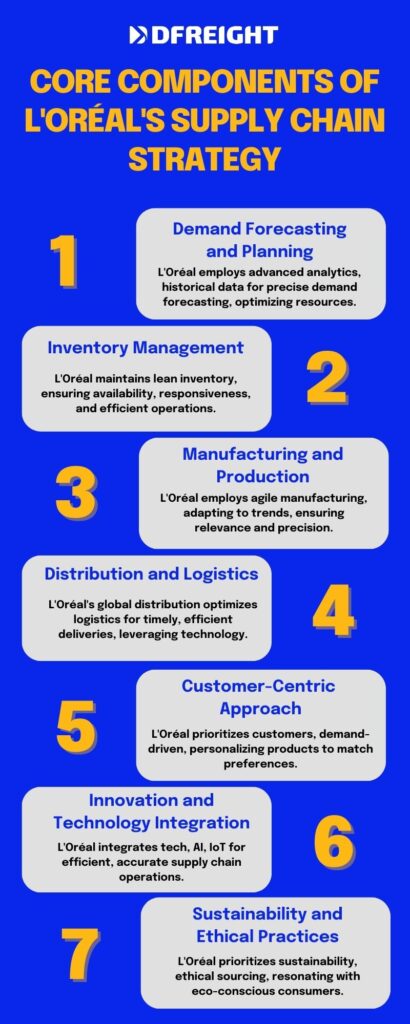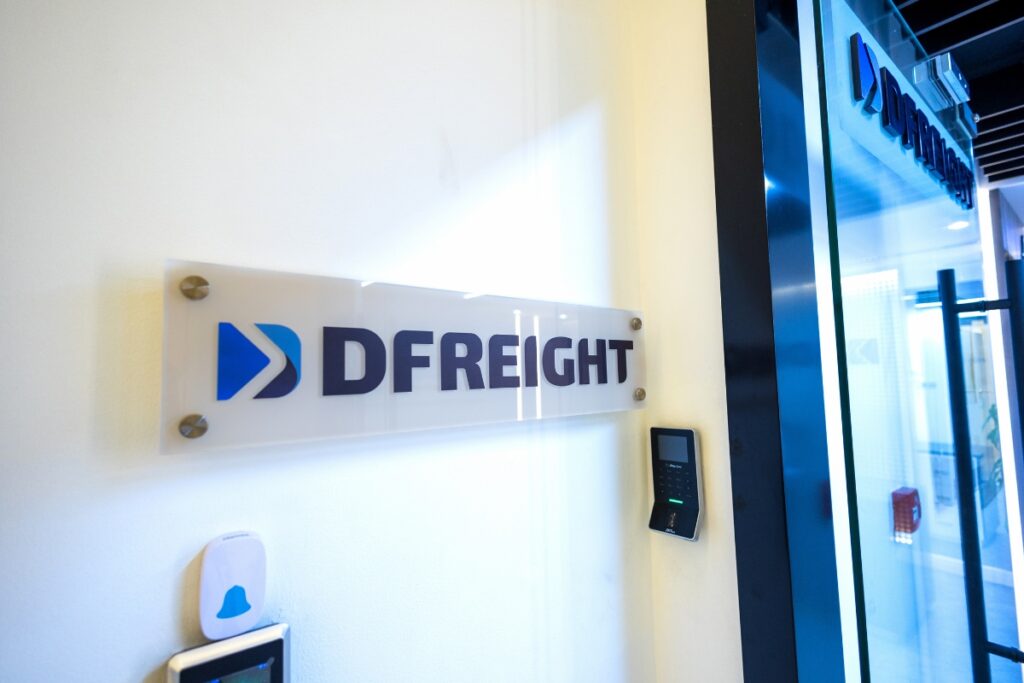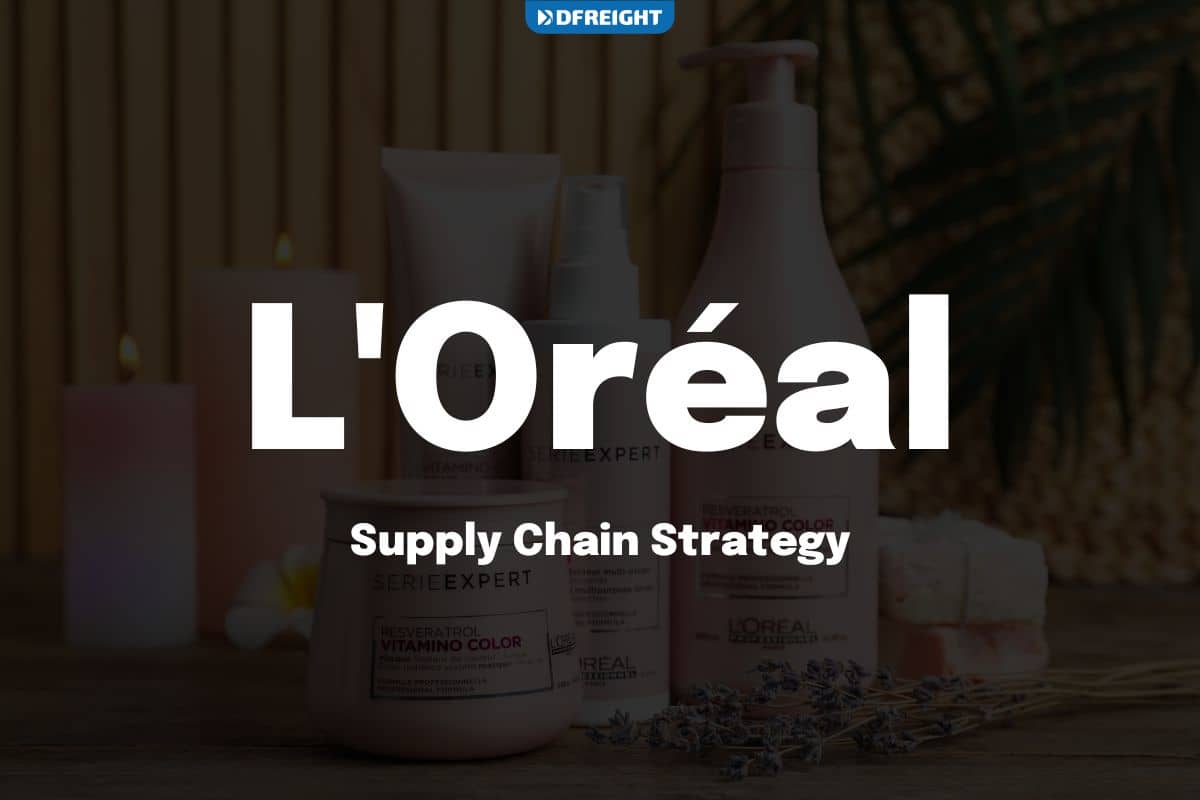In the fast-paced world of cosmetics and beauty, where trends evolve as quickly as the seasons, an efficient and effective supply chain strategy is nothing short of essential. Among the global giants of this industry, L’Oréal stands out not only for its iconic products but also for its meticulously crafted supply chain strategy. So, let’s begin our exploration of Loreal supply chain strategy, uncovering the methodologies and principles that keep the beauty flowing, shelves stocked, and customers delighted.
Experience the future of cosmetics shipping with DFreight, the digital freight forwarder that brings simplicity and efficiency to your logistics needs. Our online platform and mobile app enable you to manage and monitor cosmetic shipments seamlessly. From obtaining quotes to real-time tracking, DFreight offers a user-friendly solution that ensures your cosmetics reach their destination safely and on schedule. Trust in our specialized handling and packaging expertise to preserve the integrity of your products throughout the shipping journey. Embrace a new era of convenience and reliability with DFreight for all your cosmetic shipping requirements.
This blog post delves into the inner workings of L’Oréal’s supply chain, uncovering the strategies and practices that have enabled the company to maintain its position at the forefront of the beauty industry.
Table of Contents
The Crucial Role of Supply Chain Strategy
In the cosmetics industry, where trends can emerge and fade in a matter of weeks, having the right products available at the right time is paramount. A robust supply chain strategy is what enables companies like L’Oréal to synchronize their operations, from sourcing raw materials to delivering finished products. By doing so, they can respond swiftly to market demands, minimize waste, optimize costs, and ensure customer satisfaction.
Evolution of Loreal Supply Chain
The journey of L’Oréal’s supply chain strategy is a testament to the company’s adaptability, innovation, and commitment to staying ahead in the dynamic world of cosmetics and beauty. From its humble beginnings to its current global prominence, L’Oréal’s supply chain has evolved significantly, shaped by industry trends, technological advancements, and changing consumer preferences.
Early Days: Building the Foundation
In its early years, L’Oréal’s supply chain was characterized by traditional processes that focused primarily on manufacturing and distribution efficiency. The company’s growth was driven by its dedication to product quality and an expanding product line. During this phase, supply chain management was relatively more straightforward, focusing on meeting local demand.
Shift to Globalization: Scaling Up Operations
As L’Oréal expanded its reach beyond its home market in France, its supply chain strategy had to adapt to the challenges of global operations. The company’s expansion into new regions required efficient cross-border logistics, localized manufacturing, and streamlined distribution networks. L’Oréal began establishing a more extensive supplier base, diversifying sourcing to ensure a stable supply of raw materials.
Technology and Innovation: Transforming Operations
The turn of the millennium marked a significant shift in L’Oréal’s supply chain strategy by integrating technology and data-driven practices. Advanced supply chain management systems, predictive analytics, and digital platforms were adopted to enhance demand forecasting accuracy, optimize inventory levels, and improve production planning. This transition allowed L’Oréal to respond rapidly to market shifts and consumer preferences, reducing lead times and enhancing product availability.
Customer-Centric Approach: Personalization and Agility
As consumer preferences evolved towards personalization and customization, L’Oréal adapted its supply chain to cater to these demands. The company introduced flexible manufacturing processes allowing smaller production runs and quicker product launches. This agility enabled L’Oréal to respond to emerging trends swiftly, ensuring its products remained relevant and desirable in a competitive market.
Sustainability and Ethical Practices: Supply Chain Responsibility
In recent years, L’Oréal has strongly emphasized sustainability and ethical practices throughout its supply chain. This shift reflects a broader industry trend towards environmentally conscious consumerism. L’Oréal implemented measures to source responsibly, reduce waste, and minimize the environmental impact of its operations. These initiatives align with consumer values and contribute to cost savings and long-term viability.
The Present and Beyond: Continuous Innovation
L’Oréal’s supply chain evolution is driven by the company’s commitment to staying at the forefront of the beauty industry. Integrating artificial intelligence, machine learning, and advanced analytics continues to refine demand forecasting, optimize production processes, and enhance logistics efficiency. Additionally, L’Oréal’s focus on digital engagement and e-commerce necessitates agile supply chain solutions to meet the demands of online retail.
| Learn more |
| Zara Supply Chain Strategy |
| H&M Supply Chain Strategy |
| Nike Supply Chain Strategy |
| Adidas Supply Chain Strategy |
L’Oréal’s supply chain evolution reflects its ability to adapt, innovate, and align with changing market dynamics. From its early days of local manufacturing to its present-day global and tech-integrated operations, L’Oréal’s supply chain strategy is a blueprint for success in the cosmetics industry. By embracing globalization, technology, sustainability, and customer-centricity, L’Oréal continues to create a seamless and efficient supply chain that drives its success as a global beauty powerhouse.
Core Components of Loreal Supply Chain Strategy
L’Oréal’s remarkable success in the cosmetics industry can be attributed, in part, to its meticulously designed supply chain strategy. The company’s ability to consistently deliver high-quality products to a global customer base is underpinned by several core components that work in harmony to ensure efficiency, agility, and customer satisfaction.

1. Demand Forecasting and Planning
Its sophisticated demand forecasting and planning process is at the heart of L’Oréal’s supply chain strategy. The company utilizes advanced analytics and historical data to predict consumer trends and demand patterns. This allows L’Oréal to adjust production levels and inventory management strategies to meet anticipated market needs. By accurately forecasting demand, L’Oréal minimizes the risk of overstocking or understocking products, optimizing resource allocation and reducing costs.
2. Inventory Management
L’Oréal’s commitment to lean inventory practices helps balance maintaining product availability and reducing excess stock. Through real-time visibility into inventory levels across its distribution network, the company ensures that products are available when and where customers need them. Efficient inventory management also helps L’Oréal respond promptly to changing market demands and new product launches.
3. Manufacturing and Production
L’Oréal’s production process is characterized by flexibility and innovation. The company employs agile manufacturing techniques to adjust production volumes and introduce new product variations quickly. This flexibility is crucial in an industry where trends shift rapidly, allowing L’Oréal to keep its product portfolio relevant and precisely meet consumer preferences.
4. Distribution and Logistics
L’Oréal’s extensive distribution network spans the globe, and its logistics operations are finely tuned to ensure timely and accurate deliveries. The company leverages data analytics and technology to optimize routes, minimize transportation costs, and reduce delivery times. L’Oréal’s distribution centers are strategically located to serve different regions efficiently, enabling the company to reach its customers promptly while minimizing its carbon footprint.
5. Customer-Centric Approach
Understanding that consumers are at the heart of its success, L’Oréal employs a customer-centric approach throughout its supply chain. The company’s demand-driven strategy ensures that products are available when and where customers want them. L’Oréal’s focus on personalization and customization aligns with changing consumer preferences for unique and tailored beauty solutions.
6. Innovation and Technology Integration
L’Oréal embraces technological advancements to enhance its supply chain operations. From utilizing artificial intelligence for demand forecasting to implementing Internet of Things (IoT) sensors for real-time inventory tracking, the company integrates cutting-edge technologies to optimize efficiency and accuracy in its supply chain processes.
7. Sustainability and Ethical Practices
A hallmark of L’Oréal’s supply chain strategy is its dedication to sustainability and ethical practices. The company’s commitment to responsible sourcing, environmentally friendly packaging, and reduced waste aligns with consumer expectations for conscious consumption. This contributes to L’Oréal’s brand image and resonates with an increasingly eco-conscious customer base.
L’Oréal’s supply chain strategy is a harmonious fusion of diverse components that work cohesively to ensure product availability, responsiveness, and sustainability. By leveraging demand forecasting, efficient inventory management, agile manufacturing, robust distribution, customer-centric practices, technology integration, and ethical principles, L’Oréal has cultivated a supply chain that is a model for success in the cosmetics industry. This holistic approach has allowed the company to meet market demands consistently, stay ahead of trends, and deliver on its promise of beauty to millions worldwide.
Challenges and Future Outlook for Loreal Supply Chain Strategy
While L’Oréal has successfully developed a sophisticated and efficient supply chain strategy, it is not immune to the challenges and disruptions that can impact any global business. Looking ahead, the company must continue to innovate and adapt to address emerging trends and overcome potential obstacles in the ever-evolving cosmetics industry.
Challenges in the Changing Landscape
- Rapidly Shifting Consumer Preferences: Consumer preferences in the beauty industry can change in the blink of an eye. Keeping up with these trends and ensuring that the supply chain is agile enough to respond swiftly is a significant challenge.
- Sustainability Pressures: As sustainability becomes increasingly important to consumers, L’Oréal’s supply chain must evolve to incorporate eco-friendly practices, responsible sourcing, and reduced environmental impact.
- E-commerce Expansion: The rise of e-commerce demands different supply chain capabilities, including efficient last-mile delivery and optimized online shopping experiences. Adapting to this digital landscape requires ongoing adjustments.
- Global Uncertainties: Geopolitical factors, trade regulations, and economic shifts can impact supply chain dynamics. L’Oréal must navigate these uncertainties to maintain a stable and efficient supply chain.
- Supply Chain Disruptions: Natural disasters, pandemics, and other unforeseen events can disrupt supply chains. Building resilience to such disruptions through contingency planning is essential.
Future Outlook and Strategies
- Digitalization and Technology Integration: L’Oréal’s future supply chain strategy will likely involve integrating emerging technologies like blockchain for transparent sourcing and IoT for real-time tracking. This will enhance supply chain visibility and decision-making.
- Personalization and Customization: As personalization continues to be a trend, L’Oréal might explore further customization options, requiring more flexible and responsive supply chain processes.
- Sustainability as a Driver: The company’s commitment to sustainability will drive innovative practices such as using recyclable materials, reducing waste, and exploring carbon-neutral transportation options.
- Data-Driven Insights: L’Oréal can leverage big data and analytics for more accurate demand forecasting, helping to optimize inventory levels, reduce costs, and meet consumer demands more effectively.
- Collaboration and Supplier Relationships: Strengthening collaboration with suppliers and partners can lead to better risk management, cost optimization, and innovative ideas for improving supply chain efficiency.
- Resilience Building: L’Oréal will likely invest in building a more resilient supply chain, with backup suppliers, diversified sourcing, and contingency plans to mitigate disruptions.
Loreal supply chain strategy has come a long way, driven by innovation, technology, and a commitment to excellence. However, the future landscape will bring both opportunities and challenges. By staying attuned to changing consumer behaviors, embracing technological advancements, prioritizing sustainability, and cultivating a proactive approach to challenges, L’Oréal is poised to continue its legacy as a global beauty leader. Through ongoing evolution and adaptation, the company can ensure its supply chain remains a cornerstone of its success in the ever-evolving cosmetics industry.
DFreight: Revolutionizing Shipping and Supply Chain Management for the Cosmetics Industry
Imagine a world where shipping cosmetics is as effortless as applying your favorite shade of lipstick. Enter DFreight, the trailblazer turning this vision into reality by infusing innovation into the heart of shipping and supply chain management within the dazzling cosmetics industry.
With brilliance, DFreight’s digital platform and mobile app have unraveled the complexities that often shadow the shipment of cosmetics. Like a makeup artist’s expert touch, DFreight’s technological finesse ensures real-time tracking that’s more precise than a cat-eye flick and document management as seamless as blending foundation.
Fragile as a glass perfume bottle, cosmetics demand exceptional care during transit—here, DFreight’s expertise truly shines, guaranteeing that each product glides through its journey with the grace it deserves.
From adhering to stringent regulations with the swiftness of a precision eyeliner application to catering to the ever-changing whims of the cosmetics market with the agility of a shimmering eyeshadow palette, DFreight has transformed shipping into an art form, enhancing supply chain visibility with every step.
With DFreight, cosmetics businesses receive logistical solutions and a partner that understands the vibrancy, fragility, and time sensitivity that defines the beauty world.

Conclusion
In a world where beauty is an ever-evolving canvas, L’Oréal has mastered the art and redefined the strokes. Through an insightful exploration of L’Oréal’s supply chain strategy, we’ve uncovered the harmonious symphony of innovation, sustainability, customer-centricity, and technological integration that drives the company’s success.
As we conclude this journey, it’s evident that L’Oréal’s supply chain strategy isn’t just about products; it’s a masterpiece carefully crafted to capture hearts, mirror trends, and exceed expectations in an industry where every shade, scent, and texture matters, L’Oréal stands as a beacon, guiding us through the remarkable intersection of cosmetics and supply chain brilliance.
How does L’Oréal manage its global supply chain network?
L’Oréal balances central oversight with regional autonomy, maintaining quality standards while adapting to local market dynamics.
What role does technology play in Loreal supply chain strategy?
Technology, including AI and data analytics, enhances demand forecasting, production planning, and real-time tracking.
How does L’Oréal ensure product availability through its supply chain?
L’Oréal uses advanced analytics to forecast demand and manage inventory, ensuring products are available globally.
How does L’Oréal address disruptions in its supply chain?
L’Oréal has a comprehensive risk management strategy to address disruptions, including alternative sourcing options, diversified suppliers, and contingency plans for unforeseen events like natural disasters or geopolitical changes.














